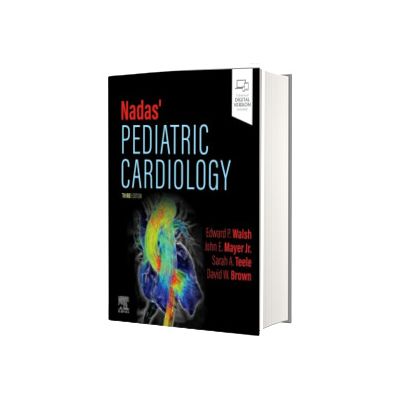Nadas Pediatric Cardiology

DESCRIERE
In recent years, the field of pediatric cardiology has undergone rapid change, resulting in earlier diagnoses and improved long-term outcomes for many patients. Nadas' Pediatric Cardiology, 3rd Edition, offers an easy-to-understand, practical, and team-based approach to this complex field, addressing the current needs of pediatric cardiologists, surgeons, fellows, and other members of the pediatric cardiology team. It thoroughly covers all diagnostic and management aspects of both acquired and congenital heart disease, providing a strong foundation and an actionable approach to care of the pediatric cardiology patient and family.
-
Table of Contents
-
Copyright
-
Dedication
-
Contributors
-
Foreword
-
Preface
-
Video contents
-
List of Illustrations
-
List of Tables
-
Section I. Historical Notes
-
1. A brief history of pediatric cardiology and congenital heart surgery
-
References
-
Section II. Developmental Anatomy and Physiology
-
2. Cardiac embryology
-
Early human development
-
Week 3
-
Week 4
-
Week 5
-
Week 6
-
Week 7
-
Week 8
-
Acknowledgments
-
References
-
3. Morphologic-anatomic diagnosis: Normal and pathologic cardiac morphology
-
Cardiac structure
-
Heart location
-
Segmental morphology
-
Segmental analysis
-
Types of human hearts
-
Summary
-
Acknowledgments
-
References
-
4. Fetal and transitional circulation
-
Fetal circulation
-
Transitional circulation
-
References
-
Section III. Cardiac Genetics
-
5. Genetics of congenital heart disease
-
Introduction
-
Cardiac development
-
Clinical considerations
-
Conclusions
-
References
-
6. Dysmorphology and syndromes
-
Introduction
-
Patterns of syndromic congenital cardiac malformations
-
Teratogens
-
Chromosomal syndromes
-
Contiguous gene deletion syndromes
-
Single gene disorders
-
Reference
-
Section IV. Noninvasive Tools of Diagnosis
-
7. History, physical examination, oximetry, chest radiograph, and other baseline testing
-
Patient history
-
Physical examination
-
Routine laboratory tests
-
Acknowledgments
-
References
-
8. Electrocardiography
-
Cardiac electrical activity
-
The electrocardiogram
-
Ambulatory ECG monitoring
-
References
-
9. Echocardiography
-
Technical background
-
M-mode echocardiography
-
Two-dimensional echocardiography
-
Three-dimensional echocardiography
-
Doppler echocardiography
-
Contrast echocardiography
-
Objectives of the echocardiographic examination
-
Echocardiographic views
-
Interpretation and reporting
-
Quantitative analysis
-
Special echocardiographic procedures
-
Fetal echocardiography
-
Safety and complications
-
References
-
10. Advanced cardiac imaging
-
Magnetic resonance imaging
-
Cardiac computed tomography
-
References
-
11. Assessment of myocardial performance
-
Introduction
-
Myocardial versus ventricular mechanics
-
Systolic myocardial and ventricular mechanics
-
Diastolic myocardial and ventricular mechanics
-
Myocardial and ventricular compliance
-
Torsion
-
The effect of heart rate on cardiac performance
-
Understanding stress echocardiography basics: Assessment of ischemia
-
References
-
12. Exercise testing
-
Physiology of exercise
-
Central hemodynamics
-
Conduct of an exercise test
-
Interpretation of exercise physiology tests
-
References
-
Section V. Cardiac Catheterization
-
13. Fundamentals of cardiac catheterization
-
Introduction
-
Indications for cardiac catheterization
-
Risks of catheterization
-
Hemodynamic evaluation
-
Oxygen content and saturation
-
Angiographic evaluation
-
References
-
14. Interventional cardiac catheterization
-
Transcatheter valve dilation
-
Transcatheter valve replacement
-
Vascular interventions
-
Occlusion of shunts
-
Diagnostic and interventional catheterization in postoperative management
-
References
-
15. Lymphatic anomalies and interventions
-
Introduction
-
Basic lymphatic physiology and anatomy
-
Lymphatic abnormalities in congenital heart disease
-
Lymphatic imaging and interventions
-
References
-
16. Fetal cardiac interventions
-
Introduction
-
Aortic stenosis with evolving hypoplastic left heart syndrome
-
Fetal cardiac intervention for aortic stenosis: Procedure technique
-
Complications during fetal cardiac intervention procedure
-
Hypoplastic left heart syndrome with intact or highly restrictive atrial septum
-
Pulmonary atresia with intact ventricular septum
-
Technique: Fetal cardiac intervention for pulmonary atresia with intact ventricular septum
-
References
-
Section VI. Electrophysiology
-
17. Cardiac arrhythmias and antiarrhythmic drugs
-
Pathophysiology of arrhythmias
-
Premature beats
-
Tachycardias
-
Management of supraventricular tachycardia
-
Management of ventricular tachycardia
-
Sinus node dysfunction
-
Disorders of atrioventricular conduction
-
Pharmacologic therapy for arrhythmias
-
Conclusion
-
References
-
18. Electrophysiology studies and transcatheter ablation
-
Introduction
-
Historical experience and outcomes
-
Indications for electrophysiology study and ablation
-
Approach to anesthesia/sedation and periprocedural considerations
-
Equipment
-
Diagnostic electrophysiology study
-
Cardiac ablative technologies
-
Techniques for mapping and ablation of arrhythmias
-
Evaluation of ventricular arrhythmias
-
Complications of electrophysiology study and ablation
-
References
-
19. Pacemakers and anti-tachycardia devices
-
Pacemakers
-
Implantable cardioverter defibrillators
-
Complications
-
Device follow-up and remote monitoring
-
References
-
20. Inherited arrhythmia syndromes and arrhythmogenic cardiomyopathies
-
Introduction
-
Inherited arrhythmia syndromes
-
Arrhythmogenic cardiomyopathies
-
References
-
Section VII. Specific Congenital Heart Defects
-
21. Atrial septal defects
-
Definition
-
Prevalence
-
Embryology
-
Anatomy
-
Physiology
-
Clinical manifestations
-
Diagnostic techniques
-
Management
-
Course
-
Acknowledgment
-
References
-
22. Ventricular septal defects
-
Definition
-
Prevalence
-
Embryology
-
Etiology
-
Morphology/classification
-
Physiology
-
Associated anatomic disease
-
Clinical signs and symptoms
-
Diagnosis
-
Prognosis
-
Treatment
-
Intervention for VSD closure
-
References
-
23. Anomalies of the ductus arteriosus
-
Definition
-
Prevalence
-
Anatomy
-
Physiology
-
Clinical manifestations
-
Course
-
Management
-
Variations
-
Acknowledgment
-
References
-
24. Coarctation of the aorta and interrupted aortic arch
-
Coarctation
-
Interrupted aortic arch
-
References
-
25. Pulmonary stenosis
-
Definition
-
Prevalence
-
Anatomy
-
Physiology
-
Valvar pulmonary stenosis
-
Dysplastic pulmonary valve
-
Pulmonary regurgitation
-
Peripheral pulmonary stenosis
-
References
-
26. Tetralogy of fallot
-
Definition
-
Prevalence and genetics
-
Pathology
-
Physiology
-
Clinical manifestations
-
Electrocardiography
-
Chest radiography
-
Echocardiography
-
Cardiac catheterization
-
Other studies
-
Management and course
-
References
-
27. Double-outlet right ventricle
-
Definition
-
Prevalence
-
Pathology
-
References
-
28. Aortic outflow abnormalities
-
Introduction
-
Valvar aortic stenosis
-
Subaortic stenosis
-
Supravalvar aortic stenosis
-
Aortic regurgitation
-
References
-
29. D-transposition of the great arteries
-
Definition
-
Prevalence
-
Embryology
-
Anatomy
-
Physiology
-
Clinical manifestations
-
Cardiac computed tomography
-
Preoperative management
-
Course following atrial switch repair
-
Course following arterial switch procedure
-
Variations
-
Summary
-
References
-
30. Congenitally corrected transposition of the great arteries
-
Definition
-
Prevalence
-
Anatomy
-
Physiology
-
Clinical manifestations
-
Management
-
Course
-
Anatomically corrected malposition of the great arteries
-
References
-
31. Atrioventricular canal defects
-
Definition
-
Embryology and genetics
-
Anatomy and classification
-
Pathophysiology and clinical course
-
Diagnosis
-
Management
-
Complete atrioventricular canal defect
-
Transitional atrioventricular canal defect
-
Partial atrioventricular canal defect
-
Postoperative management
-
Short- and long-term outcomes
-
Care of adults with repaired atrioventricular canal defect
-
nces
-
32. Heterotaxy syndrome
-
Introduction
-
Definitions and nomenclature
-
Prevalence and etiology
-
Cardiac manifestations and diagnostic tools
-
Multidisciplinary approach to heterotaxy care
-
Acknowledgments
-
References
-
33. Mitral valve and left atrial abnormalities
-
Mitral valve disease
-
Left atrial problems
-
References
-
34. Ebstein anomaly and other tricuspid valve problems
-
Ebstein anomaly
-
Other tricuspid valve problems
-
References
-
35. Hypoplastic left heart syndrome
-
Definition
-
Prevalence and genetics
-
Anatomy
-
Physiology
-
Diagnosis and clinical manifestations
-
Management
-
Cardiac transplantation
-
Ethical issues
-
Other anatomic variants of HLHS
-
Aortic atresia with normal left ventricle
-
References
-
36. Tricuspid atresia
-
Definition
-
Prevalence
-
Anatomy
-
Physiology
-
Clinical manifestations
-
Management
-
Course
-
References
-
37. Pulmonary atresia with intact ventricular septum
-
Definition
-
Prevelance
-
Prenatal development
-
Morphology
-
Physiology
-
Clinical presentation
-
Diagnostic evaluation
-
Management
-
Prognosis
-
References
-
38. Truncus arteriosus and hemitruncus
-
Truncus arteriosus
-
Prevalence
-
Embryology
-
Anatomy
-
Physiology
-
Clinical manifestations
-
Management
-
Hemitruncus (origin of branch pulmonary artery from the ascending aorta)
-
Definition
-
Prevalence
-
Embryology
-
Pathology
-
Physiology
-
Clinical manifestations
-
Management
-
Acknowledgment
-
References
-
39. Total anomalous pulmonary venous connection
-
Definition
-
Incidence
-
Embryology
-
Anatomy
-
Physiology
-
Clinical manifestations
-
Management
-
Clinical course
-
References
-
40. Pulmonary vein stenosis
-
Clinical description
-
Risk factors and prognosis
-
Management
-
Surveillance and involvement of subspecialists
-
References
-
41. Aortopulmonary window
-
Definition
-
Prevalence
-
Embryology
-
Anatomy
-
Physiology
-
Clinical manifestations
-
Management
-
References
-
42. Coronary artery anomalies
-
Introduction
-
Anomalous origin of the left coronary artery from a pulmonary artery
-
Anomalous aortic origin of the coronary artery
-
Intraseptal or intraconal left coronary artery
-
Coronary arterial fistulae
-
References
-
43. Vascular rings, slings, and related anomalies
-
Normal left aortic arch
-
Aortic arch variants
-
Vascular rings
-
Pulmonary artery sling
-
Innominate artery compression syndrome
-
Isolated branch pulmonary artery
-
References
-
Section VIII. Other Forms of Heart Disease
-
44. Preventive cardiology
-
Introduction
-
Hypertension
-
Dyslipidemia
-
Nicotine, physical activity, and cardiovascular disease
-
Conclusion
-
References
-
45. Rheumatic fever and rheumatic heart disease
-
Introduction
-
Epidemiology
-
Pathogenesis
-
Pathology
-
Clinical manifestations
-
Ancillary studies
-
Diagnosis
-
Management
-
Prevention
-
Acknowledgment
-
References
-
46. Kawasaki disease
-
Definition
-
Prevalence
-
Etiology and pathogenesis
-
Pathology
-
Clinical manifestations
-
Management
-
Long-term follow-up
-
References
-
47. Lyme disease, COVID-19, and myocarditis
-
Lyme disease
-
Coronavirus disease 2019
-
Multisystem inflammatory syndrome in children
-
Myocarditis
-
References
-
48. Cardiomyopathies
-
Introduction
-
Dilated cardiomyopathy
-
Specific subtypes of DCM
-
Left ventricular non-compaction cardiomyopathy
-
Hypertrophic cardiomyopathy
-
Restrictive cardiomyopathy
-
References
-
49. Pericardial disease
-
Introduction
-
Pericarditis
-
Recurrent pericarditis
-
Post-pericardiotomy syndrome
-
Noninflammatory pericardial effusions
-
Tamponade
-
Constrictive pericardial disease
-
Congenital partial or complete absence of the pericardium
-
Pericardial cysts and masses
-
References
-
50. Infective endocarditis
-
Introduction
-
Epidemiology
-
Pathophysiology
-
Diagnosis
-
Treatment
-
Complications and surgical consideration
-
Prevention
-
References
-
51. Cardiac masses
-
Introduction
-
Subtypes of cardiac masses
-
References
-
Section IX. Special Problems/Diagnosis and Therapy
-
52. Evaluating murmurs, chest pain, and syncope
-
Murmurs
-
Chest pain
-
Syncope
-
References
-
53. Congestive heart failure
-
Definition
-
Epidemiology
-
Etiology
-
Pathophysiology
-
Categorization
-
Presentation
-
Evaluation
-
Management
-
Advanced heart failure
-
Mechanical circulatory support
-
Heart transplantation
-
Outcomes
-
References
-
54. Advanced cardiac therapies: Ventricular assist device and heart transplantation
-
Introduction
-
Mechanical circulatory support
-
Heart transplantation
-
References
-
55. Central nervous system sequelae of congenital heart disease
-
Introduction
-
Pathology
-
CNS imaging and monitoring
-
Risk factors for CNS injury and abnormality
-
Neuropsychological impairments
-
Psychosocial effects
-
Relationship of imaging to outcomes






OPINIA CITITORILOR